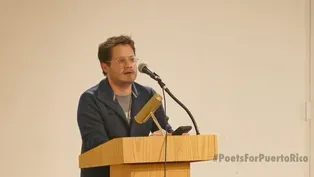
Despite owning river water rights, tribes largely cut off
Clip: 7/18/2023 | 9m 27sVideo has Closed Captions
Despite owning rights to Colorado River, tribes largely cut off from accessing water
A little-known fact about the Colorado River is that American Indian tribes own rights to about a quarter of the river. In reality, for most tribes, they are only “paper rights” not amounting to water they can use. Stephanie Sy reports on the opportunities and impediments ahead as a megadrought afflicts the Colorado and other watersheds in the West.
Problems with Closed Captions? Closed Captioning Feedback
Problems with Closed Captions? Closed Captioning Feedback
Major corporate funding for the PBS News Hour is provided by BDO, BNSF, Consumer Cellular, American Cruise Lines, and Raymond James. Funding for the PBS NewsHour Weekend is provided by...

Despite owning river water rights, tribes largely cut off
Clip: 7/18/2023 | 9m 27sVideo has Closed Captions
A little-known fact about the Colorado River is that American Indian tribes own rights to about a quarter of the river. In reality, for most tribes, they are only “paper rights” not amounting to water they can use. Stephanie Sy reports on the opportunities and impediments ahead as a megadrought afflicts the Colorado and other watersheds in the West.
Problems with Closed Captions? Closed Captioning Feedback
How to Watch PBS News Hour
PBS News Hour is available to stream on pbs.org and the free PBS App, available on iPhone, Apple TV, Android TV, Android smartphones, Amazon Fire TV, Amazon Fire Tablet, Roku, Samsung Smart TV, and Vizio.
Providing Support for PBS.org
Learn Moreabout PBS online sponsorshipGEOFF BENNETT: A little known fact about the Colorado River is that American Indian tribes own rights to about a quarter of the river.
In reality, for most tribes, there are only paper rights, not amounting to water they can actually use.
Now, as a megadrought afflicts the Colorado and other watersheds in the West, Stephanie Sy reports on the opportunities and obstacles ahead.
STEPHANIE SY: In the vast Gila River Valley south of Phoenix, Ramona Button and her husband, Terry, inspect acres of thriving crops.
Ramona left her nursing career decades ago to carry on a tribal tradition and become a farmer.
Now her heirloom tepary beans can be found at stores and restaurants around the region.
RAMONA BUTTON, Ramona Farms: The people here knew the white tepary bean, so they were very grateful that we brought it back.
STEPHANIE SY: The beans came back when the water came back.
But that took more than 100 years.
In the late 19th century, upstream users had diverted the Gila River to the point that it no longer flowed on the reservation.
Did you feel like the Gila River was stolen from the tribes here?
RAMONA BUTTON: Well, what I was told by my parents, it was taken, cut off by a dam.
And, so, many people starved to death.
I guess you would say, in the taking of it all, yes, it was stolen.
STEPHANIE SY: Her late father, who she describes as a seer, promised the land would one day be green again.
And, today, it is.
RAMONA BUTTON: I remember my dad's words: "Bring back all the foods that you were raised on."
TERRY BUTTON, Ramona Farms: It wasn't overnight.
It was a long process.
It took until just now.
We're within the last three years of finally finishing the delivery system to bring these waters to these lands.
STEPHANIE SY: The water and the canals that deliver it to growers like Ramona would not have been possible without a landmark settlement in 2004 that gave the Gila River Indian Community its water back.
One of the largest Indian water settlements in American history, the agreement granted the community a whopping 653,500 acre feet of water annually.
That is more than a quarter of the amount all of metropolitan Phoenix uses in a year.
The community also received hundreds of millions of dollars for water infrastructure.
DAVID DEJONG, Director, Pima-Maricopa Irrigation Project: All of the construction that you see here, some 216 miles of canal, having been lined or pipe, all of that is emanating from the community's water settlement.
STEPHANIE SY: David DeJong is the director of the Pima-Maricopa Irrigation Project in the community and a historian who has written on tribal water issues for decades.
DAVID DEJONG: The federal government finally made right by providing funds for the community to bring its water home and restore its agricultural economy.
STEPHANIE SY: Rodney Lewis, the tribal attorney who fought for the water rights settlement, is the late father of the tribe's current governor, Stephen Roe Lewis.
GOV.
STEPHEN ROE LEWIS, Gila River Indian Community: The senior water rights versus the... STEPHANIE SY: Building on his father's legacy means conserving the water, so he takes particular pride in this water recharge station.
It allows the tribe to bank water they don't use.
It's the only place where you can still see a slice of the Gila River on the reservation.
GOV.
STEPHEN ROE LEWIS: We have returned part of the flow of the Gila River through this area.
And it's become a riparian wetlands area that we're just so, so proud of.
We have over 100 species of birds.
When we brought the water back, it was almost like the land healed itself.
STEPHANIE SY: With the Gila River no longer the reservation's main water source, the settlement granted the tribe a big chunk of Arizona's Colorado River allocation.
In fact, the tribe of 21,000 members is the largest single entitlement holder on the Colorado River in the state.
It is a reversal of fortune that few other Native American tribes have achieved.
The much larger Navajo Nation is far from settling its water claims.
Never mind farming.
Many of the more than 170,000 tribe members who live on the reservation still have to haul water to their homes.
CRYSTAL TULLEY-CORDOVA, Navajo Nation: Upwards of 40 percent of people within the Navajo Nation don't have running water.
STEPHANIE SY: Crystal Tulley-Cordova is a Navajo hydrologist.
CRYSTAL TULLEY-CORDOVA: You think about it, our sparse population, our rural living.
In addition to that, you include water quality challenges, water production challenges that exist across the Navajo Nation.
STEPHANIE SY: Water scarcity on the vast reservation is getting worse.
CRYSTAL TULLEY-CORDOVA: Primarily, the Navajo Nation historically has used groundwater.
And when you think about climate change impacts on shallow aquifers, they're vulnerable.
Navajo residents are vulnerable.
We want to be able to have water rights that are secured that we can be able to develop to be able to close the clean water access cap.
STEPHANIE SY: With a 17 million-acre reservation that borders the Colorado, the Navajo also have senior river rights.
But that's not the same as having access to water, says Navajo attorney Daniel Cordalis.
DANIEL CORDALIS, Colorado River Sustainability Campaign: So, the odds really have been stacked up against tribes since the outset to actually put this water to use.
STEPHANIE SY: So, you have all these tribes that have rights, and yet a third of the Navajo Nation doesn't have running water.
DANIEL CORDALIS: The existence of these water rights in itself does not actually transform into what we call wet water.
So, a tribe can actually retain the right itself, but not have the ability to use it or to develop it and actually get water to our tribal communities.
STEPHANIE SY: In the most recent blow to the Navajo Nation, the Supreme Court ruled last month against the nation's claim that federal treaty law requires the government to secure water for the Navajos.
Justice Brett Kavanaugh acknowledged in the opinion that allocating water in the arid regions of the American West is often a zero-sum situation.
Nearly everyone is losing water.
The Colorado is overallocated.
Two countries, seven states, 30 tribes, 40 million people rely on its precious waters.
For many tribes in the river basin, water supplies have never seemed less certain.
STEVEN ESCOBAR, Tribal Administrator, Chemehuevi Indian Tribe: Our goal is to do everything we can to start using that water so we have the capability to benefit from it on the reservation.
STEPHANIE SY: Steven Escobar is the tribal administrator of the Chemehuevi Indian Tribe on the California side of Lake Havasu, one of the Colorado River's reservoirs.
They don't have the infrastructure to divert or store all the water they are entitled to, so it just flows downstream.
California is sort of getting your unused water and undeveloped water for free.
STEVEN ESCOBAR: That's exactly what's -- what it is.
They're able to capture it and use it for free.
So, yes, they benefit financially and economically off of our unused water.
And the tribe does not benefit in one bit.
STEPHANIE SY: Escobar wants to be able to lease the tribe's unused allotment.
Governor Lewis is aware of the special position he is in.
The tribe's large allotment gives him outsized power in a time of scarcity and, he says, responsibility.
How big of a challenge now is climate change for your whole vision?
GOV.
STEPHEN ROE LEWIS: Everything were doing is critical at a time where we have to continue to model this good behavior.
When tribes are at the table and making decisions, when we're able to have the resources, we're able to bring very innovative solutions.
STEPHANIE SY: Modeling good behavior has also meant allowing thousands of acres of farmland to go fallow.
The tribe opted to leave over 100,000 acre feet of it's annual Colorado River entitlement in Lake Mead over the next three years.
In exchange, it is getting $233 million from the federal government.
GOV.
STEPHEN ROE LEWIS: That's what our elders expect of us.
That's what we want to teach our youth, is being caretakers, being stewards of the land and the water.
That is how you live in a very beautifully harsh place, is, you work together and you respect each other.
STEPHANIE SY: Respect for the land and cultural renewal are also Terry and Ramona Button's mission.
TERRY BUTTON: It becomes our responsibility to carry it on and apply it and keep the agricultural industry thriving here.
STEPHANIE SY: Do you feel like the wrong has been corrected?
RAMONA BUTTON: Yes, I do.
And we're very grateful that we were part of the system in promoting this and going after our water rights.
STEPHANIE SY: And they are not taking them for granted.
For the "PBS NewsHour" I am Stephanie Sy at the Gila River Indian Community in Sacaton, Arizona.
American Academy of Poets head on bringing poetry to people
Video has Closed Captions
Clip: 7/18/2023 | 5m 53s | First Latino head of American Academy of Poets on bringing poetry to more people (5m 53s)
Fran Drescher on actors’ strike and future of Hollywood
Video has Closed Captions
Clip: 7/18/2023 | 8m | Actors' union president Fran Drescher discusses ongoing strike and future of Hollywood (8m)
Slow pace of Ukraine's counteroffensive prompts questions
Video has Closed Captions
Clip: 7/18/2023 | 12m 24s | Slow pace of Ukraine's counteroffensive prompts military strategy questions (12m 24s)
Trump says he's target in 2020 election investigation
Video has Closed Captions
Clip: 7/18/2023 | 6m 26s | Trump says he's target in investigation into efforts to overturn 2020 election (6m 26s)
U.S. women's team prepares to defend World Cup title
Video has Closed Captions
Clip: 7/18/2023 | 6m 52s | U.S. Women's National Soccer Team on preparing for a competitive World Cup tournament (6m 52s)
Providing Support for PBS.org
Learn Moreabout PBS online sponsorshipSupport for PBS provided by:
Major corporate funding for the PBS News Hour is provided by BDO, BNSF, Consumer Cellular, American Cruise Lines, and Raymond James. Funding for the PBS NewsHour Weekend is provided by...
















